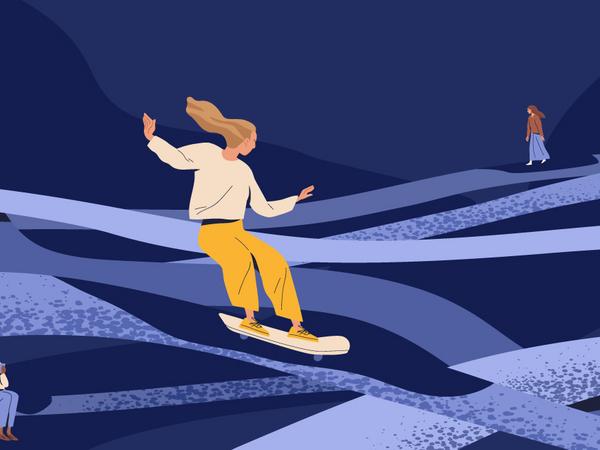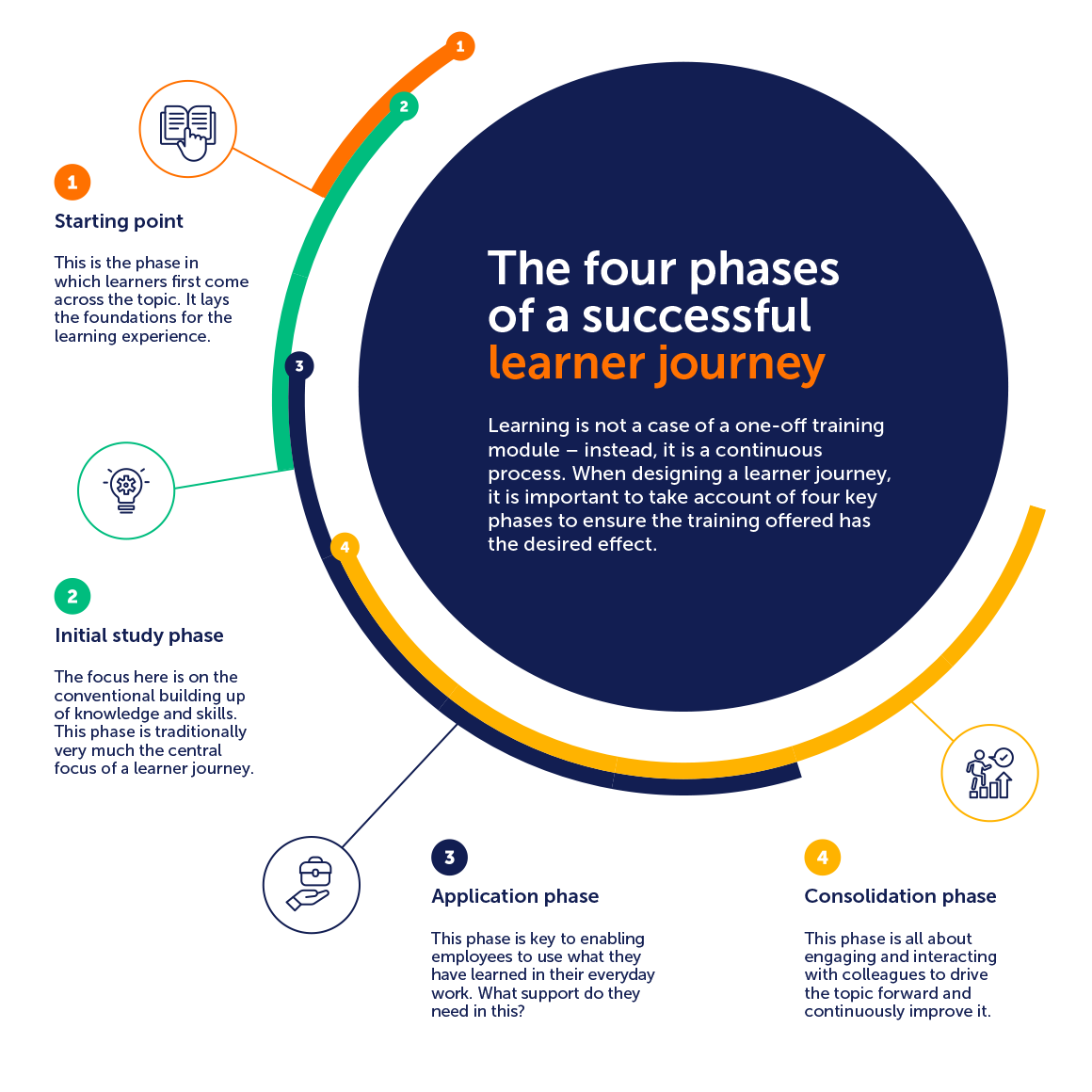The four phases of a successful learner journey

This whole concept is very much “on trend” in the corporate world. Variants range from “independent booking”, when staff plan out their own learning route, to “Silicon Valley safaris”, when participants can take a look at the latest forms of collaboration and innovation processes at start-ups. As this range shows, there are very different views in organizations about what a journey of this kind should actually look like. This is even demonstrated by the fact that, in general, the terms “learner journey” and “learning journey” are used synonymously – just like they are in this text. After all, however vivid the journey metaphor may be, each organization will approach and organize it differently in practice.
What is a learning journey?
In an era of rapid knowledge cycles, high pressure on productivity and diversified work structures, education processes that are not integrated into the actual work and take place at a separate time are rarely successful. Occasional, isolated training sessions are not, on their own, enough to enable learners to progress and acquire knowledge and new capabilities such as the much-invoked “future skills” in an agile, direct way during their actual work. Learners therefore need to be part of both a personalized and a social process. This opens up a new perspective on not only education itself, but also on tools and formats.
There are three key features:
- The focus is not on compressing content into a single workshop, a traditional training course or a digital study module. Instead, digital options linked together in a way that makes good educational sense support employees for as long as it takes for them to internalize the new knowledge and build up the relevant skills to the point that they can apply them correctly in their everyday jobs.
- As the approach is designed from the student’s perspective, learners can choose the route and activities that meet their personal needs, progress at their own speed and reach their destination independently.
- It is not a sequence of activities in the sense of a prescribed linear route within a learning management system. Instead, it describes all activities and methods that employees use to access, assimilate and, ultimately, apply a particular topic, including adding their own experiences (e.g. expectations and concerns) into the mix, interacting with colleagues and sharing their knowledge with others.
Reflecting on experiences, learning from them and applying new knowledge in a practical setting all takes time – weeks, months or even years in some cases.
Where does a learning journey start – and where does it end?
It starts with the first contact with the topic and extends through the initial learning phase and everyday application in the working context until such time as the learner has mastered the subject and can themselves play a part in consolidating and further developing the topic or the options on offer.
The concept therefore extends far beyond the formal training. The underlying idea of the process is based on the 70:20:10 principle devised by Morgan McCall, Robert W. Eichinger and Michael Lombardo back in the 1980s. To put it in very simplified terms, according to this concept, people only acquire around 10 percent of their skills through traditional methods such as seminars, eLearning or books. The bulk of knowledge acquisition – some 90 percent or so – takes place outside the traditional context, e.g. through interaction with others.
As we observe in practice time and again, the risk of failure increases if the process comes to an end before this discussion phase has taken place. If, for example, organizations roll out a collaboration tool such as Microsoft 365 and focus exclusively on how the tool is used, key aspects will be omitted, such as the important phase of collective social learning and negotiations over how the tool should be used in the everyday working context to improve collaboration. As a result, employees receive training on specific principles, but no consideration is given to the elementary phase of collaborative work. This means countless teams are created, overwhelming staff and resulting in a sense of confusion and frustration that the project isn’t taking off.
How do I develop a successful learning journey?
tts Learner Journey Template
To be successful, the journey has to encompass more than just the initial phase of knowledge acquisition – it also involves the starting point, the application in the everyday employment context and the consolidation of what has been learned through sharing, advocacy and continuous improvement. That’s because, of the four phases in total, it is only in these last two that the sustainable practical transfer of knowledge takes place – and this process is vital for subsequent value creation in the organization.
However, before we start designing the four key phases in our capacity as an HR manager or learning academy, we first need to undertake the pre-planning stage. The following points need to be clarified:
- Who are the students?
A journey is always developed from the target group’s perspective (learner personas). Materials and methods are chosen to meet individual learning needs, with an increasing focus on the learning experience, i.e. personalized educational environments and experiences. - What do students need?
Before an education program can be devised, a comprehensive assessment to identify the target group’s needs and requirements is vital. This assessment takes the form of interviews and, where appropriate, an initial assessment of the realities of the work experience. - What is the aim?
Which of the organization’s strategic or performance targets need to be supported? The more clearly the educational targets and context of the target groups are defined, the more effectively a mix of formats (e.g. blended learning) and methods that mesh together and make good educational sense can be put together.
It is clear from the points outlined above that the development of learner personas is a key success factor, since very different routes will be required for different target groups.
Four key phases of the learning journey – these are what matter
It’s now a case of fleshing out the four phases in detail. In our example, we want to drive forward digital transformation and use Microsoft 365 to make it easier for sales staff at an organization to collaborate with each other.
1. Starting point
In what context do the students first come across the topic that they will be dealing with on their learner journey? Although this may be a chance encounter, such as via the office grapevine or an informal recommendation from a colleague, it is generally in the organization’s interests to specifically design the introduction to the topic, incorporating the knowledge that has been acquired by working out the personas. How is the topic relevant to students? How should students come into contact with it? To what extent do they benefit from engaging with the topic?
This phase lays the foundation for the learning experience and the subsequent learner journey experience, so particularly close attention needs to be paid to it.
2. Initial study phase
During this phase, the focus is on the “traditional” building up of knowledge and skills. It’s all about fundamental questions such as: What goals are being pursued with the change? What is the underlying idea? How do I use the tools? How do I create a team? How do we want to make use of the new options for our future collaboration? A carefully curated mix of formats is chosen for the initial stage. This may involve devising blended learning concepts that combine online sessions, workshops, virtual classrooms, study groups or learning nuggets, for example.
This phase is traditionally very much the central point of focus. Participants find out what they ought to be able to do. All the essential foundations are laid for the subsequent application phase.
3. Application phase
In this phase, the focus is no longer on acquiring knowledge and skills, but instead on applying them on a daily basis and providing direct support in the workplace. If, for example, an employee needs to make use of a seldom-used feature of Microsoft 365 on a one-off basis, nobody wants to have to work through an entire course. Instead, what the user needs in these circumstances is quick, straightforward answers to their questions. The important thing is to provide the user with exactly the kind of efficient support they’re looking for in their moment of need. There are various suitable forms, such as performance support (e.g. step-by-step instructions), communities or social learning programs that help users help themselves.
Organizations often neglect this phase – with the result that the tool isn’t used effectively and the expected benefits in terms of productivity and efficiency are not realized.
4. Consolidation phase
The focus in this phase is on interaction with colleagues, e.g. in a community, since this helps drive forward and improve the topic. In our specific example, experienced sales staff in a “community of practice” could work on building up knowledge management based on Microsoft 365 and transferring the insights gained through this process to the learner journey for future users. When this phase is reached, participants can themselves act as mentors, helping colleagues progress or supporting them during the onboarding process by means of user-generated content, for instance.
This phase is considered the icing on the cake, since not all participants will achieve the level of expertise required for this or demonstrate the necessary commitment.
The role of HR as the “travel agent”
Even though the four phases have been set out chronologically here, this does not mean that learners actually work through them in this order. It is perfectly possible to jump between the different phases at will – the only reason for breaking the process down into the various phases is to provide guidance for structuring the learning journey. Even in phase 4, for example, it may be necessary to return to phase 2 if a new technical function becomes relevant as part of the digital transformation.
As HR managers and learning professionals, we need to ask ourselves the following fundamental question: What does our “travel agent” role in this context look like? Not all factors that contribute to the process can be planned. It is therefore important to give employees access to all the formats and options they may need – including remotely. When making the arrangements, we need to include plenty of embarkation and disembarkation points to ensure users have the option of skipping certain material. After all, focusing exclusively on the initial building up of knowledge to the extent that the whole process comes to an abrupt halt after the end of phase 2 would be a terrible waste of potential.





